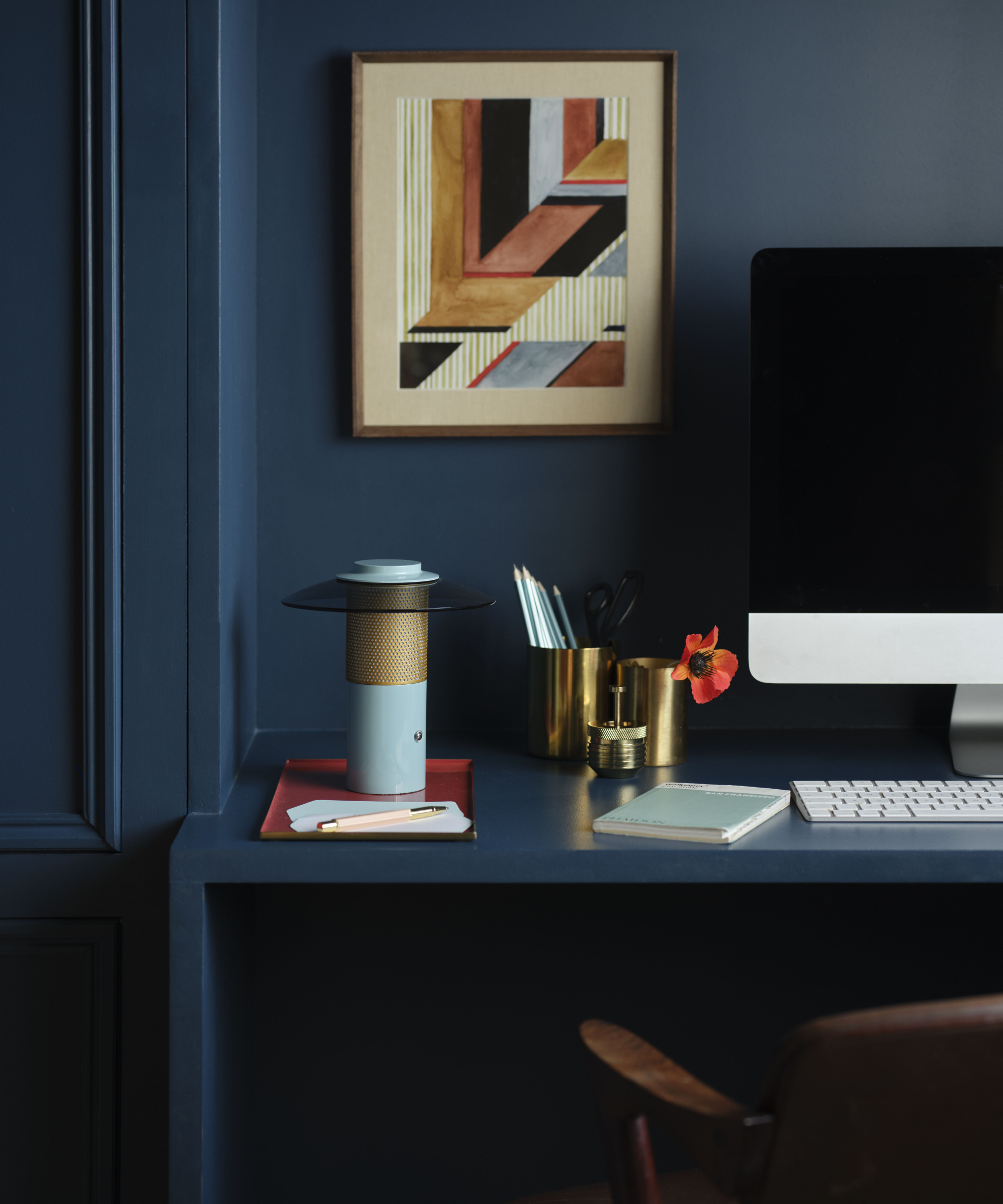Lighting a home office: An expert guide to getting it right
Follow our expert guide to lighting a home office to create a space that boosts your productivity and is easy on the eye

Lighting a home office properly is an integral part of home office design, both for the physical benefits it has on your eyes and the impact it has on creating a space that is both conducive to work but also welcoming.
It can especially feel tricky if your home office is located in a room that functions as a bedroom or living room. Creating a lighting scheme that works for work and pleasure can be a less easy task to navigate successfully.
But that's where our expert guide to lighting a home office comes in. We've spoken to the experts to find out what steps you need to take to ensure your lighting design scheme performs effectively, and looks great, so you can get on with your work .
Why is lighting a home office so important?
“Designing the optimum lighting scheme in your home office is very important as working with lack of light or the wrong kind can cause problems with eyestrain and headaches," explains Jo Plant, head of design at Pooky.
"It can also affect your mood and energy levels, so getting it right from the get-go is key to help you feel more inspired and productive."

Jo Plant is Head of Design and Production for Pooky, which is based in England’s Cotswolds region.
Where to start
Before you can start choosing lighting for your home office design ideas, you will need to think about several key factors and ask yourself certain questions in order to help you select the best lighting products and create the most effective lighting design scheme for you.
Before you begin, and in order to avoid lighting design mistakes, ask yourself the following:
- What time of day will the office be used the most?
- Who will be using the room?
- Will there be more than one person working in here at a time?
- How much natural light does the room receive and where does it enter the space?
- Are there areas you want to highlight, such as shelves or within cupboards?
- Will the room be used for other activities other than working (such as for a guest bedroom)?
For example, if you realise that two people will often be working in the room at once, you will need two sources of task lighting.
Likewise, if you come to the conclusion that you will often be working in the space in the evening, you will need to carefully think about the best artificial light sources to provide enough light for you to work comfortably.
While natural daylight is an essential source of light, if your working hours are outside these times, you need to provide extra light to compensate.

Layered lighting
“The best way to light your office space is by layering lighting and combining different kinds of light that will work together effectively," says Jo Plant.
If you have not come across the idea of 'layering' light before when it comes to lighting design ideas, the term simply refers to combining different types of light to ensure that all the requirements that a particular space demand are met.
You are probably already using layers of light elsewhere in your home, perhaps without realising it. Did your living room lighting ideas include recessed downlights and a selection of floor lamps when you designed the room? Is there a central pendant light in your bedroom along with bedside table lamps? If so, you are already layering light.
There are several different types of light that make up these layers and some are more suitable for certain rooms than others. In your home office layout, you need to consider how to incorporate three different types of lighting: ambient, task and accent.

Types of lighting
Ambient lighting
"Ambient lighting is considered as the overall light that you get in a room, this would include the main lights and the natural light available," says Jo Plant. It serves to illuminate the entire space and is usually provided by windows, a roof lantern or skylights, a central pendant light, recessed downlights or a selection of wall lights.
Task lighting
"Task lighting, also known as targeted lighting, is used to carry out specific tasks, for example if you need further attention on your screen or notepad," explains Jo. "It's a very practical type of light and in a home office, task lights often come in the form of directional desk lamps, although floor lamps and even low hung pendants over your work area can work too."
Accent lighting
"Finally," says Jo, "accent lighting is used to highlight any features or objects in the room, for instance, this can be a nice piece of art. We recommend lighting a home office with a combination of generous ambient lighting and targeted task lighting to support with all your activities.”
Accent lighting is also sometimes called directional light. Good sources include hidden LED strip lights, wall washers and uplights. While this type of lighting is not as crucial in a home office as task or ambient, it helps to make the space pleasurable to be in.

Products for lighting a home office

Minimal and super practical “swing” wall light. When it’s not in use, a simple flick of a wrist is all it takes to put it neatly against the wall.
Natural lighting
Natural light and the way in which it enters your home office is hugely important, although even if your space is flooded with natural light, you will still need some kind of artificial lighting.
“Natural light is very beneficial when considering your design lighting scheme for your home office," confirms Jo Plant. "We recommend positioning your desk or table next to a window and as close as possible to an alternative source of natural light, this can be under a skylight or by a glass door.
In small home office ideas, "if you’ve got limited access to natural light, mirrors can work as a good trick to add depth to the room and reflect the available light around it," suggests Jo. "Consider how the levels of sunlight might vary throughout the day and how you can also avoid any glares and direct light.”
Ellie Kennedy, an interior expert at 247 Blinds suggests looking at the types of window coverings to help combat any issues with glare.
“Venetian blinds, for example, are a great option for those who work from home. They can help you to angle the daylight away from laptops and monitors using the slats. Not only does this help to reduce screen glare, but it also allows for more privacy, whilst still keeping your workspace bright and airy.
"Colour and style are also very impactful in small workspaces, and your blinds can play a role in this. Try sticking to minimalist designs and neutral tones to open your space, limit distractions, and create a calm environment perfect for focus."
If you find sitting at a window too distracting, place the desk at a perpendicular angle to the window instead to still benefit from the natural light.


Ellie Kennedy is an in house interior expert at 247 Blinds. She is an authority on window dressings offering creative and practical styling advice for both blinds and curtains.
How to position lighting
The positioning of your home office lights is just as crucial as the fittings you choose.
“A grid pattern will often light dead space, but lighting towards the walls and other vertical surfaces makes rooms feel bigger and brighter" advises Luke Thomas, design director at John Cullen Lighting.
"Avoid harsh shadows on the desk area," he continues. "Place two or more low glare LED downlights to cross light the work space. Ensure fittings are positioned so that the user is not working in their own shadow — you do not want to position them behind the desk.
"When selecting a beam, go for a wide beam for any downlights and maybe consider adding a honeycomb lens to soften the light and reduce glare."


Luke has been in the lighting industry since 2008 and heads up the UK design team. Working collaboratively with top designers, architects, contractors and clients, Luke has been involved in a wide range of projects offering design-led solutions which improve our experience of spaces.
Expert tips for lighting a home office
Feeling more knowledgeable about lighting a home office? Experts share some additional tips for bringing the spark back into your workplace.
“Along with the usual desk lamp, we recommend an additional task light to enhance the light levels," says Jo Plant. "Consider a hanging pendant directly over your desk or an extendable wall light, both space-saving and beautifully decorative, these extra light sources offer flexibility for when you need more light throughout the darker seasons of the year.
“Additionally, installing dimmer switches gives you the option to control and adjust light levels to your needs, bringing a more balanced glow into your space.
“Cordless table lamps and wall lights, also make for a fantastic addition to your office," says Jo. "If you’re struggling for plug sockets being used by desk equipment, a cordless table lamp is a perfect task light alternative. Cordless wall lights also avoid the mess of installing wiring and can be easily moved around your space with the seasonal light change."
"One technique to create a comfortable and glare-free space is to incorporate wall lights into your lighting design," adds Mara Rypacek Miller, managing director and founder of Industville.
"A smart lighting system also allows you to adjust colour temperature and brightness for optimal productivity and comfort.”

FAQs
How much light does a home office need?
When designing a lighting scheme you will see two common measurements — lux and lumen.
Lux refers to how much light falls on a surface, whereas lumen indicates how much light is emitted by a light source (usually a bulb). You might also see a Kelvin level.
"The Kelvins (K) is the colour temperature and it’s best to use either 2700K or 3000K for an office," says Luke Thomas. "For a home office I would go with 2700K so it is not too stark and you achieve a softer ambience”.
Some desk lamps allow you to change the colour temperature according to your needs.
When it comes to lux levels, it is advised that for general office work, a lux level of 250 and above is required, while school classrooms require at least 300 lux and computer work areas should have 500 lux.
Searching for new bulbs? Check out our guide to the best LED bulbs before you buy and think about the tone. Jo Plant also says opting for warmer tones is a good idea.
“When working on a laptop for most of the day, the colour and intensity of lighting is vital. No strained eyes here," says Jo. "We always recommend using a soft warm yellow or white light, rather than a stark white, and use a dimmer to find the right intensity for different times of the day.”
Get the Homebuilding & Renovating Newsletter
Bring your dream home to life with expert advice, how to guides and design inspiration. Sign up for our newsletter and get two free tickets to a Homebuilding & Renovating Show near you.
Natasha was Homebuilding & Renovating’s Associate Content Editor and was a member of the Homebuilding team for over two decades. In her role on Homebuilding & Renovating she imparted her knowledge on a wide range of renovation topics, from window condensation to renovating bathrooms, to removing walls and adding an extension. She continues to write for Homebuilding on these topics, and more. An experienced journalist and renovation expert, she also writes for a number of other homes titles, including Homes & Gardens and Ideal Homes. Over the years Natasha has renovated and carried out a side extension to a Victorian terrace. She is currently living in the rural Edwardian cottage she renovated and extended on a largely DIY basis, living on site for the duration of the project.



